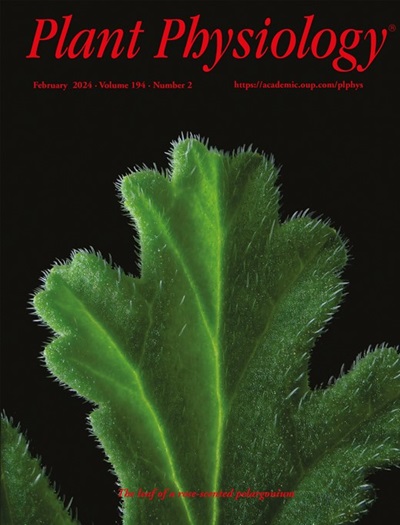光敏色素B调节皮层微管排列,通过抑制长叶来控制子叶极性扩张。
IF 6.5
1区 生物学
Q1 PLANT SCIENCES
引用次数: 0
摘要
光促进子叶的扩张并控制子叶扩张的方向性,使小的椭圆形子叶变成较大的圆形。然而,这种极地扩张背后的细胞基础仍不清楚。我们报道了拟南芥(Arabidopsis thaliana)子叶的极性扩张主要与铺路细胞的极性扩张有关,而不是与极性细胞增殖有关。光敏色素B (phyB)通过抑制光敏色素相互作用因子(pif)促进这种极性扩张,而pif通常抑制扩张并反向调节其方向性。pif部分通过激活靶基因long - folias (LNGs)来控制方向性。在细胞水平上,phyB减少了横向排列的皮质微管数量,而增加了纵向排列的微管数量。这种由phyb引起的微管排列改变会增强横向膨胀而减弱纵向膨胀。相反,pif以相反的方式调节微管排列。在phyB-PIF通路的下游,lng优先增加横向排列的皮质微管。总的来说,我们的数据支持通过phyB- pif - lng途径调节皮质微管方向是phyB如何减弱相对于横向扩张的纵向扩张,同时促进铺面细胞在光下扩张以形成圆形子叶的基础。本文章由计算机程序翻译,如有差异,请以英文原文为准。
Phytochrome B regulates cortical microtubule arrangement to control cotyledon polar expansion by repressing LONGIFOLIAs.
Light promotes the expansion and controls the directionality of expansion in cotyledons, transforming small oval cotyledons into larger orbicular shapes. However, the cellular basis underlying this polar expansion remains unclear. We report that cotyledon polar expansion in Arabidopsis (Arabidopsis thaliana) is primarily associated with the polar expansion of pavement cells, rather than with polar cell proliferation. Phytochrome B (phyB) promotes this polar expansion by inhibiting PHYTOCHROME INTERACTING FACTORs (PIFs), which normally suppress expansion and inversely regulate its directionality. PIFs exert their control over directionality partly through the activation of their target genes, LONGIFOLIAs (LNGs). At the cellular level, phyB decreases the number of transversely arranged cortical microtubules, while increasing the number of longitudinally arranged microtubules. This phyB-induced change in microtubule arrangement would strengthen transverse expansion while weakening longitudinal expansion. In contrast, PIFs regulate microtubule arrangements in the opposite manner. Downstream of the phyB-PIF pathway, LNGs preferentially increase transversely arranged cortical microtubules. Overall, our data support that the regulation of cortical microtubule orientation by the phyB-PIF-LNG pathway underlies how phyB weakens longitudinal expansion relative to transverse expansion while promoting pavement cell expansion to make orbicular cotyledons in the light.
求助全文
通过发布文献求助,成功后即可免费获取论文全文。
去求助
来源期刊

Plant Physiology
生物-植物科学
CiteScore
12.20
自引率
5.40%
发文量
535
审稿时长
2.3 months
期刊介绍:
Plant Physiology® is a distinguished and highly respected journal with a rich history dating back to its establishment in 1926. It stands as a leading international publication in the field of plant biology, covering a comprehensive range of topics from the molecular and structural aspects of plant life to systems biology and ecophysiology. Recognized as the most highly cited journal in plant sciences, Plant Physiology® is a testament to its commitment to excellence and the dissemination of groundbreaking research.
As the official publication of the American Society of Plant Biologists, Plant Physiology® upholds rigorous peer-review standards, ensuring that the scientific community receives the highest quality research. The journal releases 12 issues annually, providing a steady stream of new findings and insights to its readership.
 求助内容:
求助内容: 应助结果提醒方式:
应助结果提醒方式:


